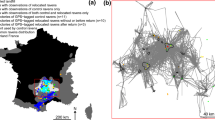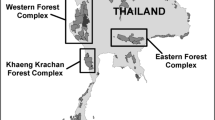Abstract
We studied the ability of Akodon azarae (Rodentia, Muridae) to return to their preferred habitat, when released at a perpendicular distance (25, 50 or 75 m) from the edge towards the cropfield, and a parallel distance (100 m) away from the site of first capture within the edge habitat. Return success was estimated as the proportion of animals recovered in edges. The recapture rate between the field and the border was significantly higher than the recapture rate estimated according to successive captures in the border. Successful returns did not decrease significantly with increasing release distance, but animals released at 50 m from edges were less successful in returning to borders than the other release-distance groups. Although the median time taken to the first recapture in edges did not differ among the release-distance groups, rodents released at 25 m and 50 m returned to edges faster than those released at 75 m. A. azarae showed both a successful return to the edge and a trend to return to the home range area. We conclude that A. azarae can return to edges from cropfields at distances that are larger than those they usually travel, allowing the use of fields when they present good conditions for reproduction and survival. Successful return is probably the result of direct movements rather than random wandering.

Similar content being viewed by others
References
Bilenca DN, Kravetz FO (1998) Seasonal variations in microhabitat use and feeding habits of the pampas mouse Akodon azarae in agroecosystems of central Argentina. Acta Theriol 43:195–203
Busch M, Kravetz FO (1992) Competitive interactions among rodents (Akodon azarae, Calomys laucha, C musculinus and Oligoryzomys flavescens) in a two-habitat system. Spatial and numerical relationships. Mammalia 56:45–56
Busch M, Miño MH, Dadon JR, Hodara K (2001) Habitat selection by Akodon azarae and Calomys laucha (Rodentia, Muridae) in pampean agroecosystems. Mammalia 65:29–48
Cavia R, Gómez Villafañe IE, Cittadino EA, Bilenca DN, Miño MH, Busch M (2005) Effects of cereal harvest on abundance and spatial distribution of the rodent Akodon azarae in central Argentina. Agric Ecosyst Environ 107:95–99
Cittadino EA, Busch M, Kravetz FO (1998) Population abundance and dispersal in Akodon azarae (pampean grassland mouse) in Argentina. Can J Zool 76:1011–1018
Ellis BA, Mills JN, Childs JE, Muzzini MC, McKee KT Jr, Enria DA, Glass GE (1997) Structure and floristics of habitats associated with five rodent species in an agroecosystem in Central Argentina. J Zool Lond 243:437–460
Gustafson EJ, Gardner RH (1996) The effect of landscape heterogeneity on the probability of patch colonization. Ecology 77:94–107
Hall AJ, Rebella CM, Ghersa CM, Culot PH (1992) Field-crop systems of the Pampas. In: Pearson CJ (ed) Field crop ecosystems. (Ecosystems of the world, vol 18) Elsevier, Amsterdam, pp 413–449
Hodara K, Busch M, Kittlein MJ, Kravetz FO (2000) Density-dependent habitat selection between maize cropfields and their borders in two rodent species (Akodon azarae and Calomys laucha) of Pampean agroecosystems. Evol Ecol 14:571–593
Jacob J, Hempel N (2003) Effects of farming practices on spatial behaviour of common voles. J Ethol 21:45–50
Macdonald DW, Tew TE, Todd IA, Garner JP, Johnson PJ (2000) Arable habitat use by wood mice (Apodemus sylvaticus) 3 A farm-scale experiment on the effects of crop rotation. J Zool Lond 250:313–320
Pardiñas UFJ, Cirignoli S (2000) Bibliografía comentada sobre los análisis de egagrópilas de aves rapaces en Argentina. Ornitol Neotrop 13:31–59
Redford KH, Eisenberg JF (1992) Mammals of the neotropics, vol 2. The southern cone. University of Chicago, Chicago
Robinson WL, Bruce Falls J (1965) A study of homing of meadow mice. Am Midl Nat 73:188–223
Sánchez López MI (1998) Factores que limitan la abundancia de los roedores múridos en el Delta del Paraná. PhD thesis, University of Buenos Aires, Buenos Aires, 150 pp
Suárez OV, Kravetz FO (1998) Copulatory pattern and mating system of Akodon azarae (Rodentia, Muridae). Ihering Ser Zool 84:133–140
With KA, Gardner RH, Turner MG (1997) Landscape connectivity and population distributions in heterogeneous environments. Oikos 78:151–169
Zollner PA (2000) Comparing the landscape level perceptual abilities of forest sciurids in fragmented agricultural landscapes. Landscape Ecol 15:523–533
Zollner PA, Lima SL (1997) Landscape-level perceptual abilities in white-footed mice: perceptual range and the detection of forested habitat. Oikos 80:51–60
Zollner PA, Lima SL (1999) Search strategies for landscape-level inter-patch movements. Ecology 80:1019–1030
Acknowledgements
This work was funded by grants of the University of Buenos Aires (UBACYT TX 058) and CONICET (PIP 547/98), Argentina.
Author information
Authors and Affiliations
Corresponding author
About this article
Cite this article
Hodara, K., Busch, M. Return to preferred habitats (edges) as a function of distance in Akodon azarae (Rodentia, Muridae) in cropfield-edge systems of central Argentina. J Ethol 24, 141–145 (2006). https://doi.org/10.1007/s10164-005-0173-3
Received:
Accepted:
Published:
Issue Date:
DOI: https://doi.org/10.1007/s10164-005-0173-3




